最近在学习论文的时候发现了在science上发表的关于新型的基于密度的聚类算法
Kmean算法有很多不足的地方,比如k值的确定,初始结点选择,而且还不能检测费球面类别的数据分布,对于第二个问题,提出了Kmean++,而其他不足还没有解决,dbscan虽然可以对任意形状分布的进行聚类,但是必须指定一个密度阈值,从而去除低于此密度阈值的噪音点,这篇文章解决了这些不足。
本文提出的聚类算法的核心思想在于,对聚类中心的刻画上,而且认为聚类中心同时具有以下两种特点:
- 本身的密度大,即它被密度均不超过它的邻居包围
- 与其他密度更大的数据点之间的“距离”相对更大

通俗的理解为:给一个节点求与其距离小于一个值的节点的个数,用这个个数表示节点的密度,此时求出来的就是节点的局部密度,

经过上边的过程,每个点都可以找到两个距离与之对应,然后建立一个二维坐标轴,在坐标轴上把图形画出来,如下图

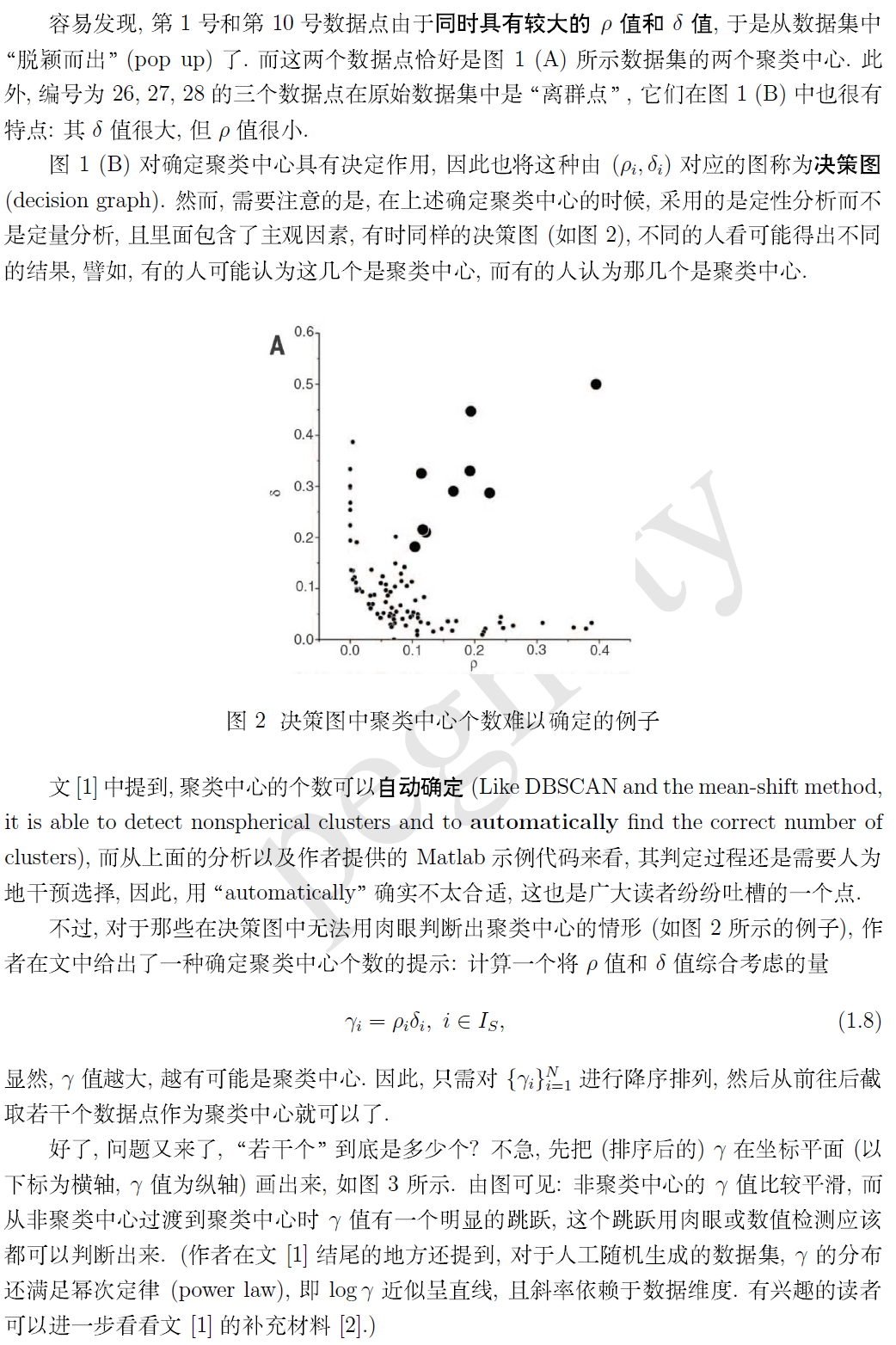
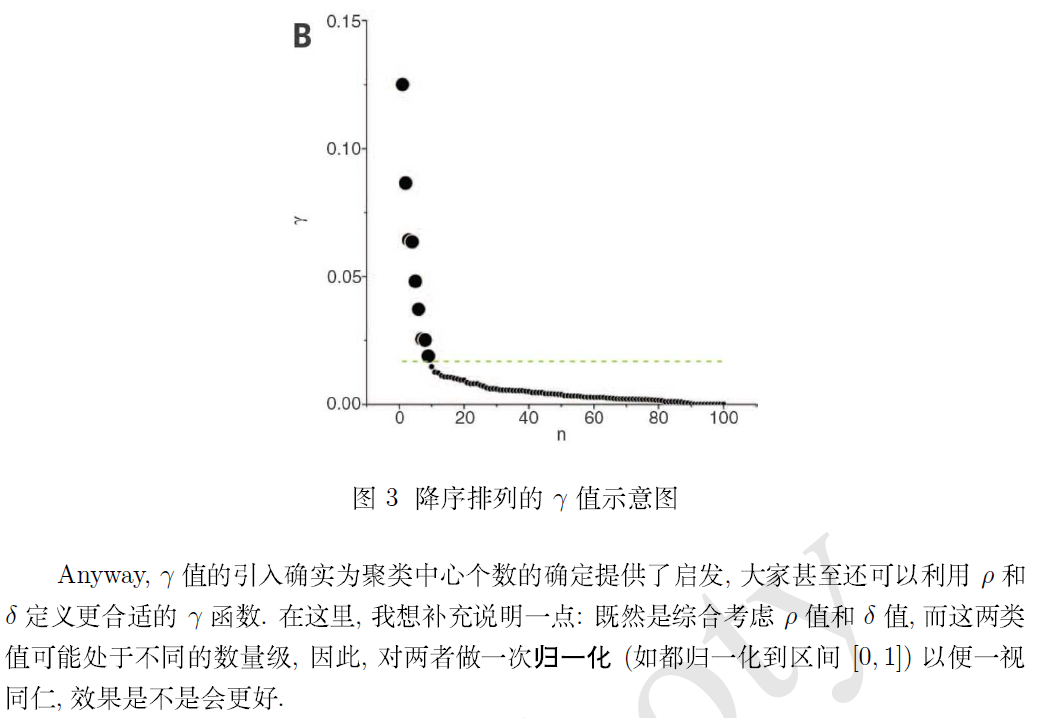
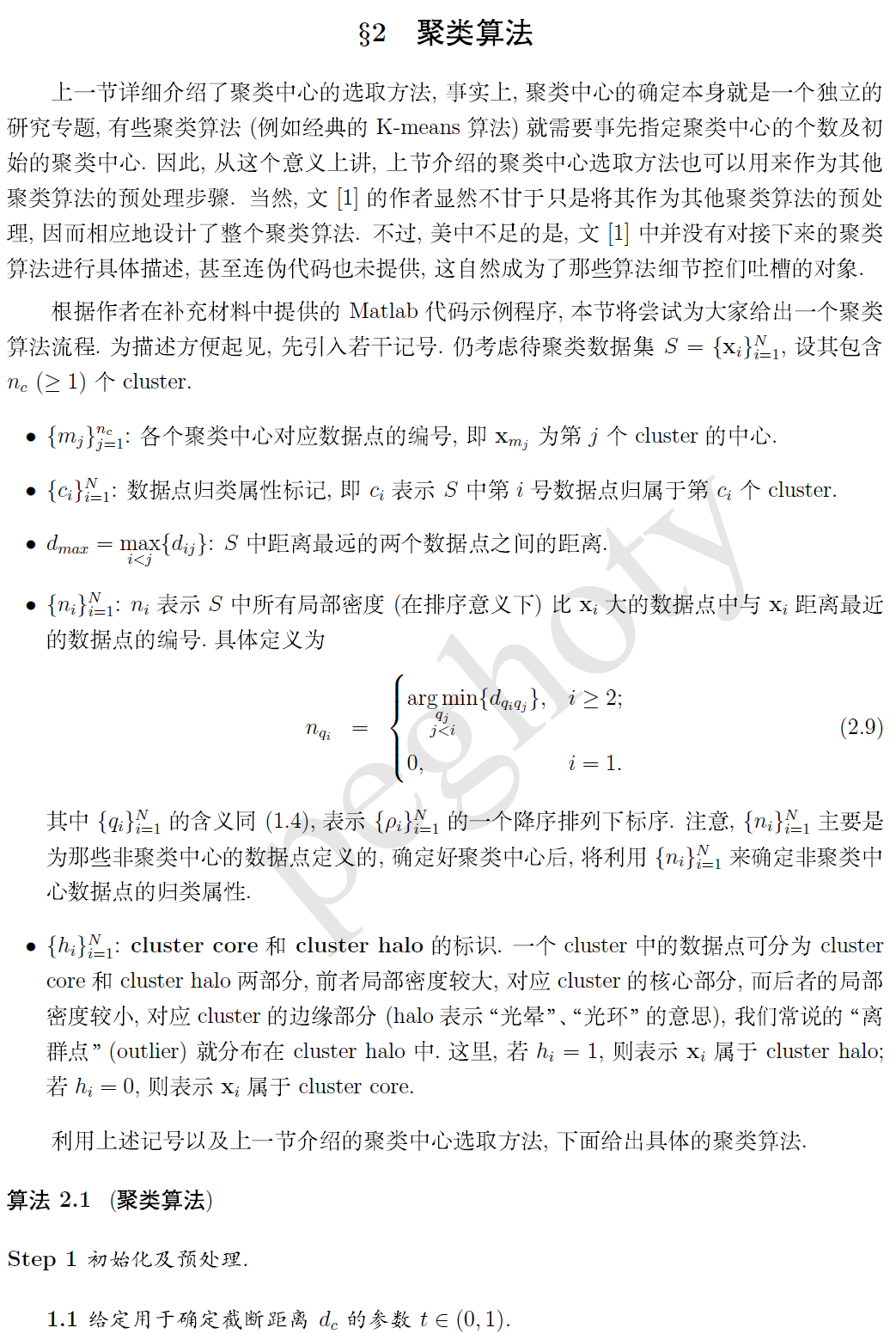


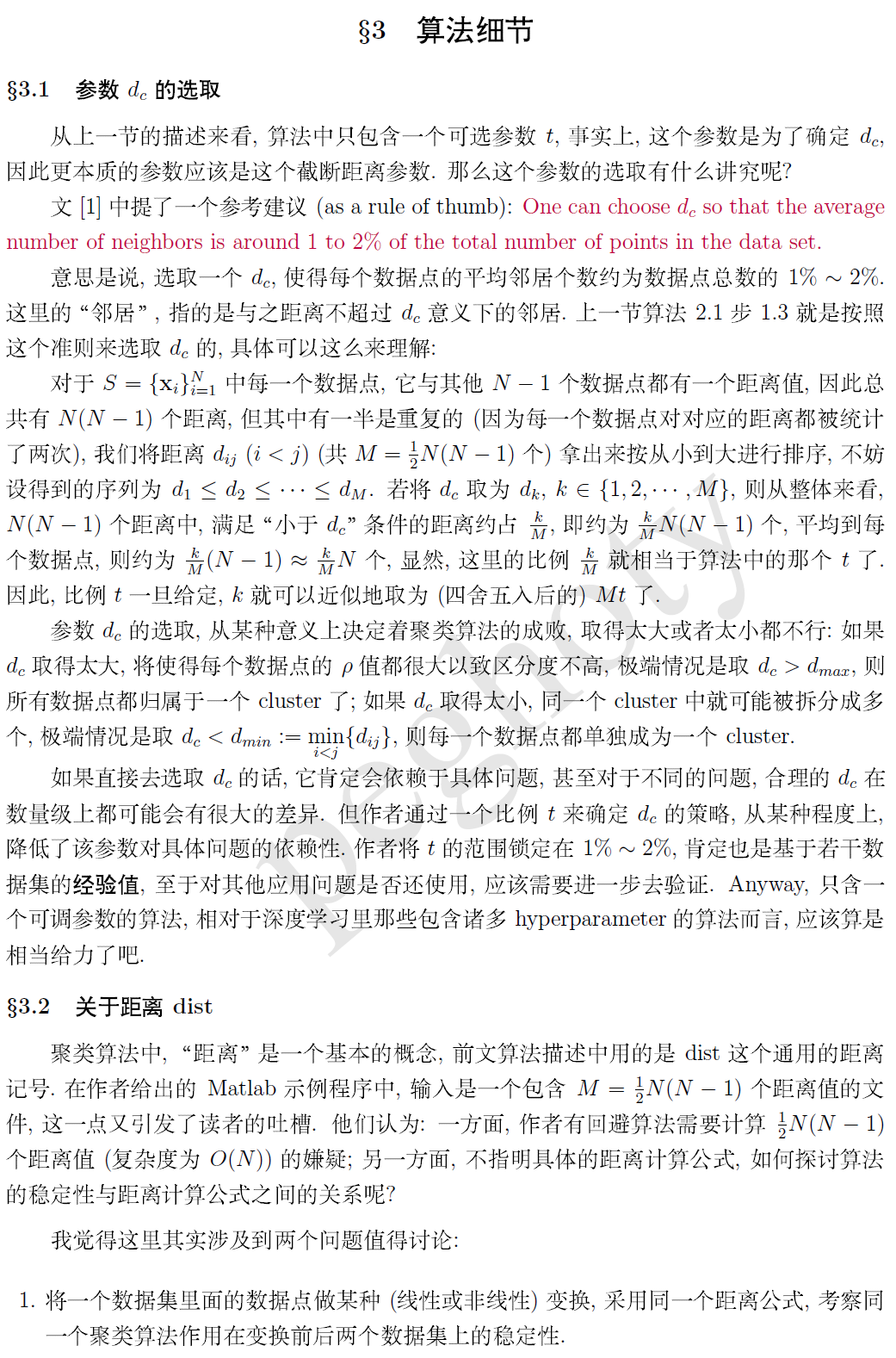
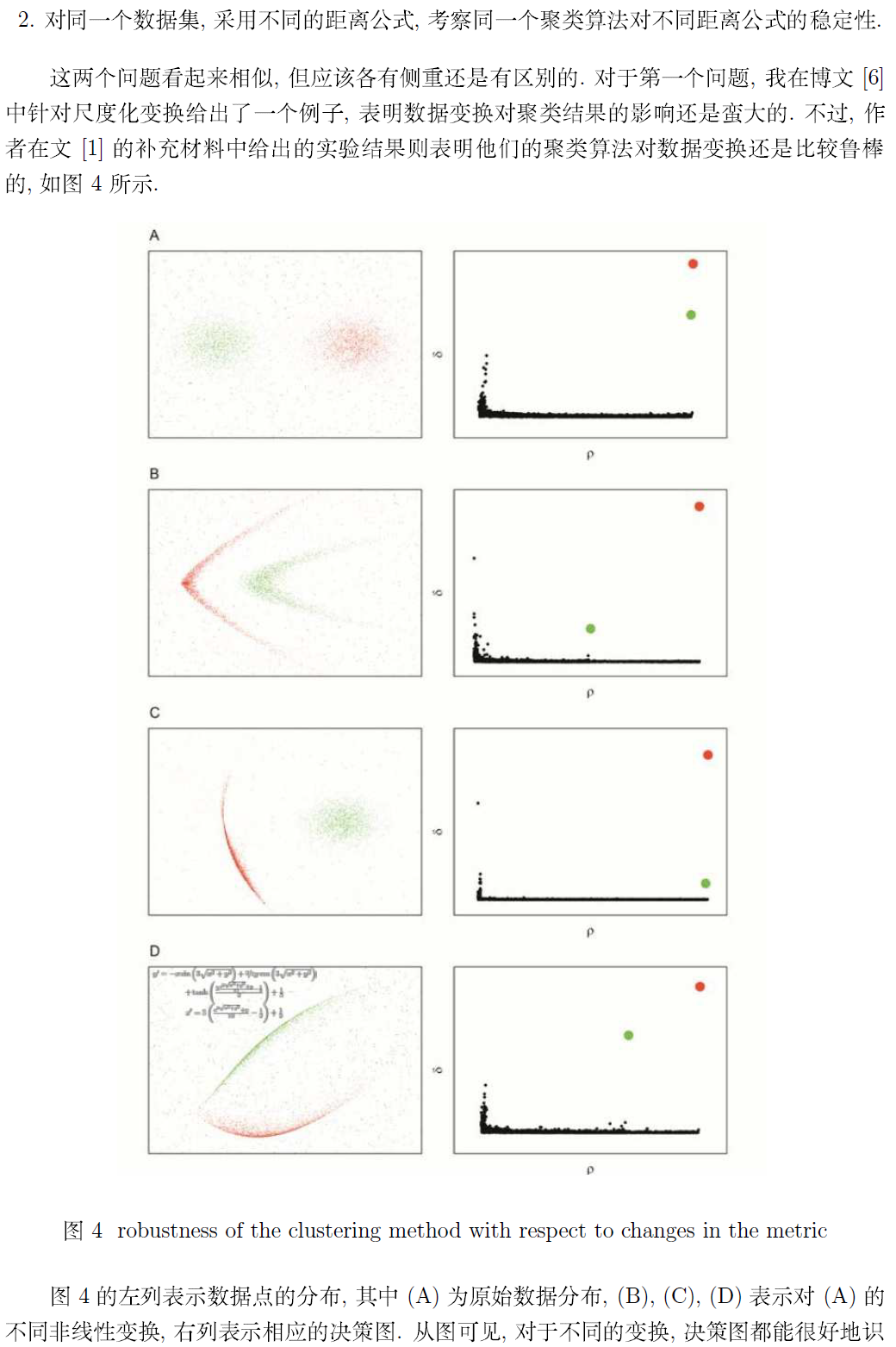


最后,附上作者在补充材料里提供的 Matlab 示例程序 (加了适当的代码注释)
clear all close all disp('The only input needed is a distance matrix file') disp('The format of this file should be: ') disp('Column 1: id of element i') disp('Column 2: id of element j') disp('Column 3: dist(i,j)') %% 从文件中读取数据 mdist=input('name of the distance matrix file (with single quotes)? '); disp('Reading input distance matrix') xx=load(mdist); ND=max(xx(:,2)); NL=max(xx(:,1)); if (NL>ND) ND=NL; %% 确保 DN 取为第一二列最大值中的较大者,并将其作为数据点总数 end N=size(xx,1); %% xx 第一个维度的长度,相当于文件的行数(即距离的总个数) %% 初始化为零 for i=1:ND for j=1:ND dist(i,j)=0; end end %% 利用 xx 为 dist 数组赋值,注意输入只存了 0.5*DN(DN-1) 个值,这里将其补成了满矩阵 %% 这里不考虑对角线元素 for i=1:N ii=xx(i,1); jj=xx(i,2); dist(ii,jj)=xx(i,3); dist(jj,ii)=xx(i,3); end %% 确定 dc percent=2.0; fprintf('average percentage of neighbours (hard coded): %5.6f ', percent); position=round(N*percent/100); %% round 是一个四舍五入函数 sda=sort(xx(:,3)); %% 对所有距离值作升序排列 dc=sda(position); %% 计算局部密度 rho (利用 Gaussian 核) fprintf('Computing Rho with gaussian kernel of radius: %12.6f ', dc); %% 将每个数据点的 rho 值初始化为零 for i=1:ND rho(i)=0.; end % Gaussian kernel for i=1:ND-1 for j=i+1:ND rho(i)=rho(i)+exp(-(dist(i,j)/dc)*(dist(i,j)/dc)); rho(j)=rho(j)+exp(-(dist(i,j)/dc)*(dist(i,j)/dc)); end end % "Cut off" kernel %for i=1:ND-1 % for j=i+1:ND % if (dist(i,j)<dc) % rho(i)=rho(i)+1.; % rho(j)=rho(j)+1.; % end % end %end %% 先求矩阵列最大值,再求最大值,最后得到所有距离值中的最大值 maxd=max(max(dist)); %% 将 rho 按降序排列,ordrho 保持序 [rho_sorted,ordrho]=sort(rho,'descend'); %% 处理 rho 值最大的数据点 delta(ordrho(1))=-1.; nneigh(ordrho(1))=0; %% 生成 delta 和 nneigh 数组 for ii=2:ND delta(ordrho(ii))=maxd; for jj=1:ii-1 if(dist(ordrho(ii),ordrho(jj))<delta(ordrho(ii))) delta(ordrho(ii))=dist(ordrho(ii),ordrho(jj)); nneigh(ordrho(ii))=ordrho(jj); %% 记录 rho 值更大的数据点中与 ordrho(ii) 距离最近的点的编号 ordrho(jj) end end end %% 生成 rho 值最大数据点的 delta 值 delta(ordrho(1))=max(delta(:)); %% 决策图 disp('Generated file:DECISION GRAPH') disp('column 1:Density') disp('column 2:Delta') fid = fopen('DECISION_GRAPH', 'w'); for i=1:ND fprintf(fid, '%6.2f %6.2f ', rho(i),delta(i)); end %% 选择一个围住类中心的矩形 disp('Select a rectangle enclosing cluster centers') %% 每台计算机,句柄的根对象只有一个,就是屏幕,它的句柄总是 0 %% >> scrsz = get(0,'ScreenSize') %% scrsz = %% 1 1 1280 800 %% 1280 和 800 就是你设置的计算机的分辨率,scrsz(4) 就是 800,scrsz(3) 就是 1280 scrsz = get(0,'ScreenSize'); %% 人为指定一个位置,感觉就没有那么 auto 了 :-) figure('Position',[6 72 scrsz(3)/4. scrsz(4)/1.3]); %% ind 和 gamma 在后面并没有用到 for i=1:ND ind(i)=i; gamma(i)=rho(i)*delta(i); end %% 利用 rho 和 delta 画出一个所谓的“决策图” subplot(2,1,1) tt=plot(rho(:),delta(:),'o','MarkerSize',5,'MarkerFaceColor','k','MarkerEdgeColor','k'); title ('Decision Graph','FontSize',15.0) xlabel (' ho') ylabel ('delta') subplot(2,1,1) rect = getrect(1); %% getrect 从图中用鼠标截取一个矩形区域, rect 中存放的是 %% 矩形左下角的坐标 (x,y) 以及所截矩形的宽度和高度 rhomin=rect(1); deltamin=rect(2); %% 作者承认这是个 error,已由 4 改为 2 了! %% 初始化 cluster 个数 NCLUST=0; %% cl 为归属标志数组,cl(i)=j 表示第 i 号数据点归属于第 j 个 cluster %% 先统一将 cl 初始化为 -1 for i=1:ND cl(i)=-1; end %% 在矩形区域内统计数据点(即聚类中心)的个数 for i=1:ND if ( (rho(i)>rhomin) && (delta(i)>deltamin)) NCLUST=NCLUST+1; cl(i)=NCLUST; %% 第 i 号数据点属于第 NCLUST 个 cluster icl(NCLUST)=i;%% 逆映射,第 NCLUST 个 cluster 的中心为第 i 号数据点 end end fprintf('NUMBER OF CLUSTERS: %i ', NCLUST); disp('Performing assignation') %% 将其他数据点归类 (assignation) for i=1:ND if (cl(ordrho(i))==-1) cl(ordrho(i))=cl(nneigh(ordrho(i))); end end %% 由于是按照 rho 值从大到小的顺序遍历,循环结束后, cl 应该都变成正的值了. %% 处理光晕点,halo这段代码应该移到 if (NCLUST>1) 内去比较好吧 for i=1:ND halo(i)=cl(i); end if (NCLUST>1) % 初始化数组 bord_rho 为 0,每个 cluster 定义一个 bord_rho 值 for i=1:NCLUST bord_rho(i)=0.; end % 获取每一个 cluster 中平均密度的一个界 bord_rho for i=1:ND-1 for j=i+1:ND %% 距离足够小但不属于同一个 cluster 的 i 和 j if ((cl(i)~=cl(j))&& (dist(i,j)<=dc)) rho_aver=(rho(i)+rho(j))/2.; %% 取 i,j 两点的平均局部密度 if (rho_aver>bord_rho(cl(i))) bord_rho(cl(i))=rho_aver; end if (rho_aver>bord_rho(cl(j))) bord_rho(cl(j))=rho_aver; end end end end %% halo 值为 0 表示为 outlier for i=1:ND if (rho(i)<bord_rho(cl(i))) halo(i)=0; end end end %% 逐一处理每个 cluster for i=1:NCLUST nc=0; %% 用于累计当前 cluster 中数据点的个数 nh=0; %% 用于累计当前 cluster 中核心数据点的个数 for j=1:ND if (cl(j)==i) nc=nc+1; end if (halo(j)==i) nh=nh+1; end end fprintf('CLUSTER: %i CENTER: %i ELEMENTS: %i CORE: %i HALO: %i ', i,icl(i),nc,nh,nc-nh); end cmap=colormap; for i=1:NCLUST ic=int8((i*64.)/(NCLUST*1.)); subplot(2,1,1) hold on plot(rho(icl(i)),delta(icl(i)),'o','MarkerSize',8,'MarkerFaceColor',cmap(ic,:),'MarkerEdgeColor',cmap(ic,:)); end subplot(2,1,2) disp('Performing 2D nonclassical multidimensional scaling') Y1 = mdscale(dist, 2, 'criterion','metricstress'); plot(Y1(:,1),Y1(:,2),'o','MarkerSize',2,'MarkerFaceColor','k','MarkerEdgeColor','k'); title ('2D Nonclassical multidimensional scaling','FontSize',15.0) xlabel ('X') ylabel ('Y') for i=1:ND A(i,1)=0.; A(i,2)=0.; end for i=1:NCLUST nn=0; ic=int8((i*64.)/(NCLUST*1.)); for j=1:ND if (halo(j)==i) nn=nn+1; A(nn,1)=Y1(j,1); A(nn,2)=Y1(j,2); end end hold on plot(A(1:nn,1),A(1:nn,2),'o','MarkerSize',2,'MarkerFaceColor',cmap(ic,:),'MarkerEdgeColor',cmap(ic,:)); end %for i=1:ND % if (halo(i)>0) % ic=int8((halo(i)*64.)/(NCLUST*1.)); % hold on % plot(Y1(i,1),Y1(i,2),'o','MarkerSize',2,'MarkerFaceColor',cmap(ic,:),'MarkerEdgeColor',cmap(ic,:)); % end %end faa = fopen('CLUSTER_ASSIGNATION', 'w'); disp('Generated file:CLUSTER_ASSIGNATION') disp('column 1:element id') disp('column 2:cluster assignation without halo control') disp('column 3:cluster assignation with halo control') for i=1:ND fprintf(faa, '%i %i %i ',i,cl(i),halo(i)); end
参考:http://blog.csdn.net/aimatfuture/article/details/39405261
http://blog.csdn.net/zxdxyz/article/details/40655231